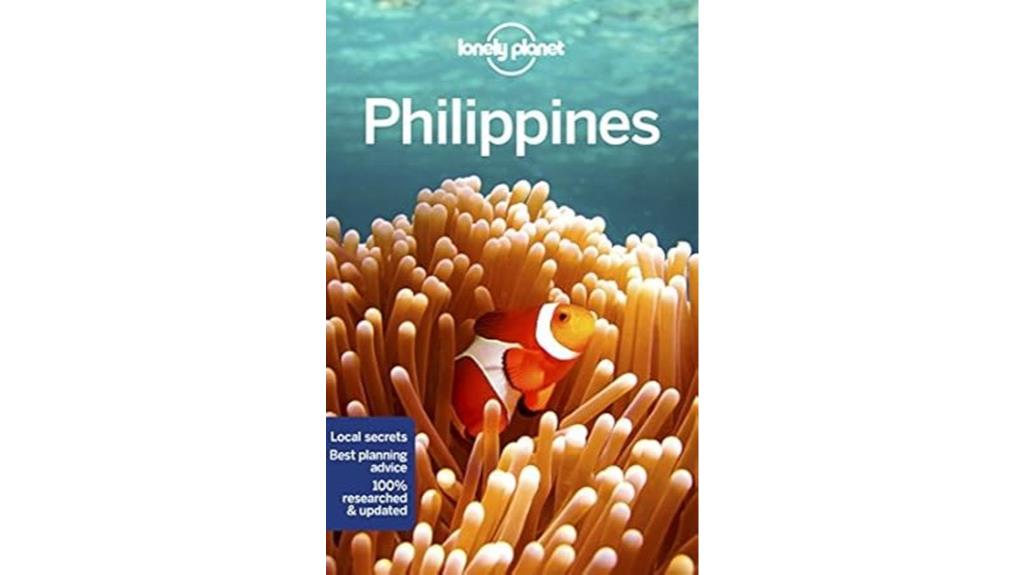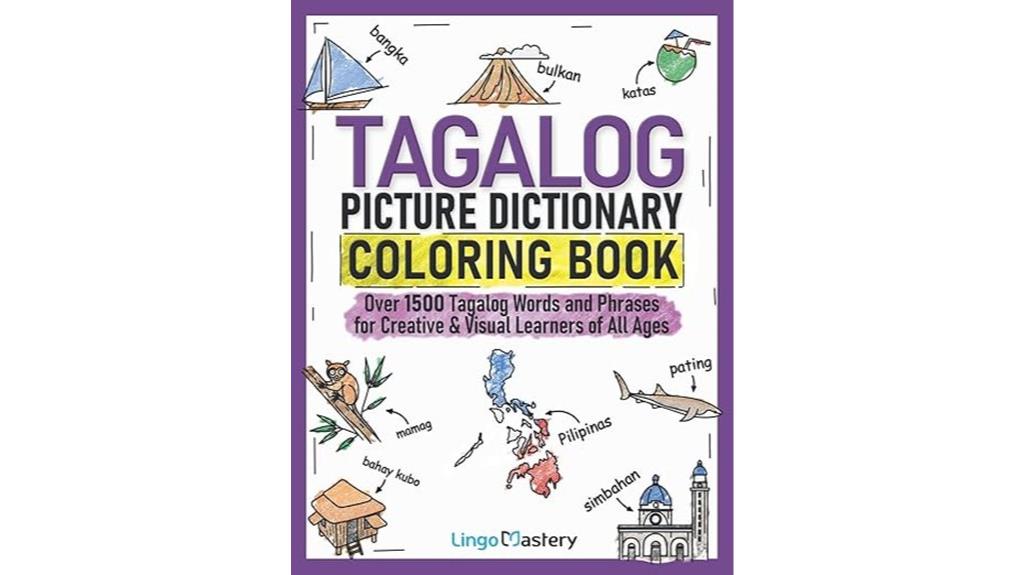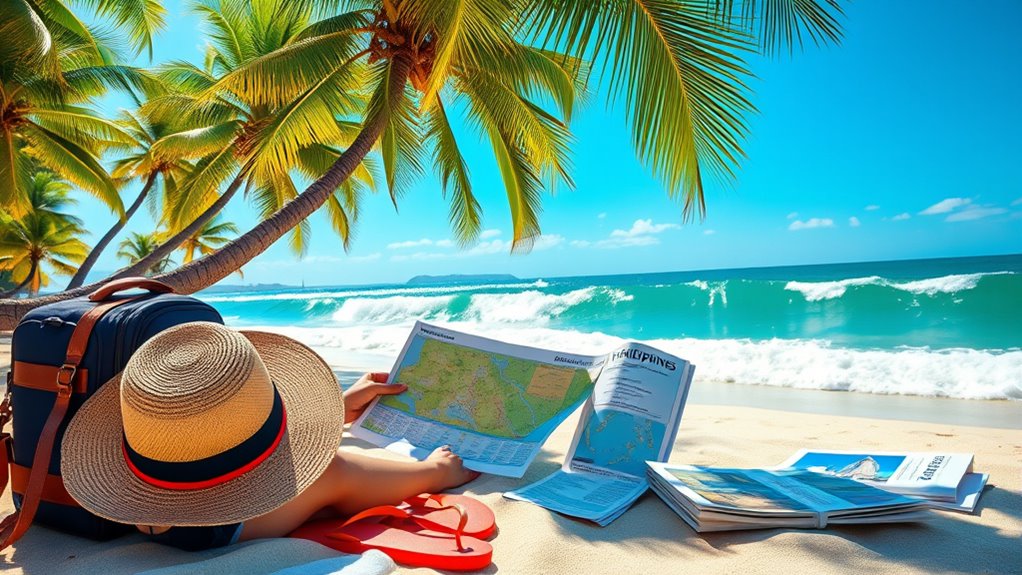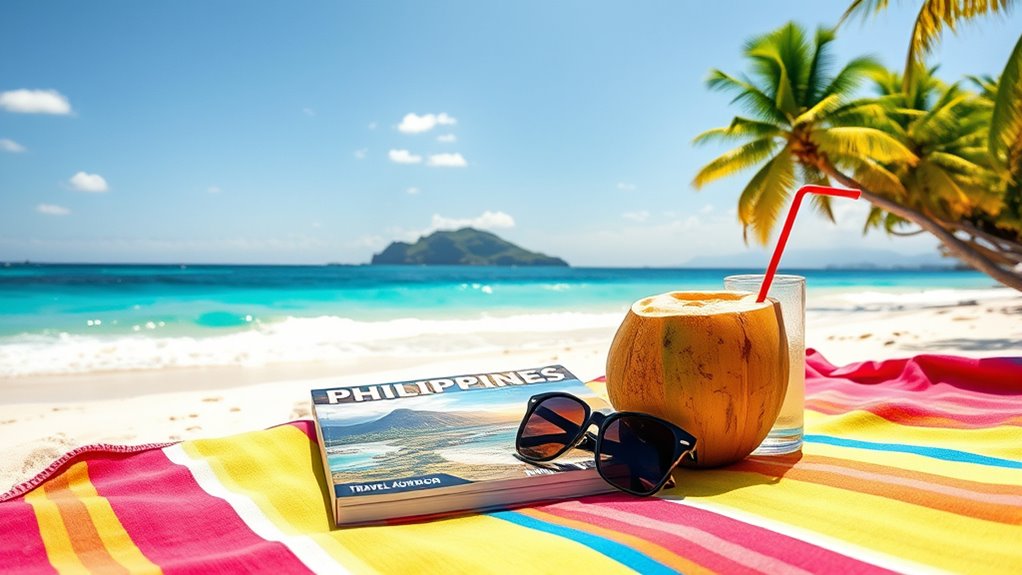Finding the right travel insurance for your Philippines adventure is vital. I recommend checking out guides like “Lonely Planet Philippines 13” for travel itineraries and tips. Don’t miss “Easy Tagalog Phrase Book” for practical language essentials and consider “Philippines – Culture Smart!” for cultural insights. Finally, make sure to understand coverage limits and premium factors, which can vary greatly. If you stick around, you’ll discover even more essential tips for your journey.
Key Takeaways
- Choose travel insurance that covers medical expenses, trip cancellation, and lost or delayed baggage for comprehensive protection during your Philippines adventure.
- Review policy exclusions carefully, especially for pre-existing conditions and natural disasters, to avoid surprises during your trip.
- Ensure the insurance provider offers 24/7 emergency assistance services for medical emergencies and travel delays while in the Philippines.
- Compare travel insurance quotes from multiple providers to find the best coverage options and prices that fit your travel itinerary.
- Select coverage duration that matches your trip length, with options for extensions in case of unexpected changes or emergencies.
Philippines – Culture Smart!: The Essential Guide to Customs & Culture

If you’re planning to visit the Philippines and want to truly connect with its vibrant culture, “Philippines – Culture Smart!: The Essential Guide to Customs & Culture” is the perfect companion for you. This book dives into the heart of Filipino customs and traditions, making it a must-read, whether you’re a seasoned traveler or a first-timer. I found it invaluable in understanding both the similarities and differences between Filipino and Western lifestyles. It offers practical communication tips that really helped me connect with locals. Plus, its engaging style makes learning about Filipino culture enjoyable and enlightening. Don’t miss it!
Best For: Travelers and individuals looking to deepen their understanding of Filipino culture and customs, whether they are first-time visitors or seasoned travelers.
Pros:
- Engaging style: The book makes learning about Filipino culture enjoyable and entertaining.
- Practical tips: It provides valuable communication strategies to help connect with locals effectively.
- Cultural insights: Readers gain a deeper appreciation for Filipino traditions and customs, highlighting both similarities and differences with Western lifestyles.
Cons:
- Limited language focus: While it emphasizes Tagalog vocabulary, it may not cover other Filipino languages extensively.
- Generalization of culture: Some readers might find that cultural nuances are oversimplified in certain areas.
- Not exhaustive: It may not cover every aspect of Filipino culture, leaving out some lesser-known customs and practices.
Lonely Planet Philippines 13 (Travel Guide)

For anyone planning an adventure in the Philippines, the “Lonely Planet Philippines 13” travel guide is an invaluable resource, especially if you’re looking to explore vibrant festivals like the Masskara in Bacolod or the Dinagyang in Iloilo. I found it incredibly helpful for traversing from NAIA terminals to downtown Bacolod and Iloilo. The guide’s layout and colorful pictures made it visually appealing, and the itineraries are spot on. It also provided essential travel tips, though I learned to be cautious with transport reservations. Overall, it’s a must-have for any backpacker or independent traveler wanting to uncover the Philippines’ hidden gems.
Best For: Backpackers and independent travelers seeking comprehensive insights into the Philippines’ culture, festivals, and hidden gems.
Pros:
- Provides essential travel tips and itineraries that streamline the travel experience.
- Visually appealing layout with colorful pictures enhances the overall reading experience.
- Contains helpful information on local language and transport options, making navigation easier.
Cons:
- Some inaccuracies in electrical information, which can lead to inconvenience.
- Transport reservations may be challenging due to high demand, requiring careful planning.
- Prices can vary significantly, with potential for being overcharged compared to local standards.
Easy Tagalog Phrase Book: Common Phrases for Everyday Use and Travel

The “Easy Tagalog Phrase Book” is perfect for anyone enthusiastic to explore the Philippines while connecting with locals. With over 1,500 phrases organized into 20 topics, it covers everything from greetings to transportation, making it a handy companion. Although English is widely spoken, knowing Tagalog can prevent miscommunication and enrich your experience. I found the mass sentence approach effective for immersion, but I recommend using audio resources to improve pronunciation. While it’s an excellent supplement for learners, it’s best to pair it with other tools for a deeper understanding of conversational Tagalog. Happy travels!
Best For: Travelers and language enthusiasts looking to connect with locals in the Philippines through essential Tagalog phrases.
Pros:
- Comprehensive collection of over 1,500 phrases organized into 20 practical topics.
- Effective immersion learning with a mass sentence approach for language retention.
- Enhances travel experience by preventing miscommunication and fostering local interactions.
Cons:
- Lacks detailed guidance on using phrases in conversational contexts.
- May require additional resources, such as audio materials, for optimal pronunciation practice.
- Not ideal for quick learning, particularly for tourists on a short visit.
Tagalog Picture Dictionary Coloring Book

A fantastic resource for anyone enthusiastic to learn Tagalog while preparing for an adventure in the Philippines is the Tagalog Picture Dictionary Coloring Book. I found it incredibly effective for visual learners like me, as it combines coloring with vocabulary building. With over 1500 words and phrases, it truly enhances my understanding. Discussing the pictures with a friend brings the content to life, making it even more engaging. It’s perfect for travelers and even retirees wanting to brush up on their skills. This book turns learning into a fun experience, keeping my motivation high as I get ready for my trip!
Best For: The Tagalog Picture Dictionary Coloring Book is best for creative and visual learners, travelers to the Philippines, and retirees looking to improve their conversational skills.
Pros:
- Engaging and enjoyable learning experience through coloring and vocabulary building.
- Comprehensive vocabulary foundation with over 1500 Tagalog words and phrases.
- Supports interaction and discussion, enhancing understanding and retention of the language.
Cons:
- May not be as effective for auditory or kinesthetic learners who prefer different learning styles.
- Requires interaction with others for maximum effectiveness, which may not be feasible for all learners.
- Some users might find the coloring aspect distracting rather than helpful for their learning process.
Factors to Consider When Choosing Travel Insurance Guides for Philippines Trips

When choosing travel insurance for my trips to the Philippines, I focus on several key factors. I consider the types of coverage available, any exclusions that might surprise me, and the cost versus the benefits. Plus, I always check the duration of coverage to make sure I’m protected for the entire trip.
Coverage Types Available
Choosing the right travel insurance for your adventure in the Philippines can feel overwhelming, especially with various coverage types available. I’ve found that focusing on key areas can help simplify the decision. Medical expenses coverage is vital since healthcare costs can be high, especially in emergencies. Trip cancellation insurance is another important factor; it can reimburse you for non-refundable costs if you need to cancel due to illness or natural disasters. Also, don’t overlook lost or delayed baggage coverage—it’s essential in case of airline mishaps. Finally, personal liability coverage provides peace of mind, protecting you if you accidentally injure someone or damage property. By understanding these options, you’ll be better prepared for your trip.
Exclusions to Watch For
While understanding the coverage types is important, it’s equally vital to be aware of the exclusions that might affect your travel plans in the Philippines. Many policies won’t cover pre-existing medical conditions, so I always review the terms carefully. If you’re planning on scuba diving or engaging in extreme sports, be prepared for specific exclusions or the need for additional coverage. Natural disasters, common in the Philippines, might not be included in standard policies, so I check for coverage related to typhoons or earthquakes. Also, remember that incidents related to alcohol or drug use are often excluded. Finally, not all insurers cover cancellations due to travel advisories, so I verify my policy provides adequate protection in such scenarios.
Emergency Assistance Services
Having reliable emergency assistance services in your travel insurance can make a world of difference during your adventures in the Philippines. I can’t stress enough the significance of having 24/7 helplines ready to support you in emergencies. Many policies cover essential medical emergencies like hospital admissions and medical evacuations, which are crucial, especially in remote areas. Plus, some providers offer help with lost luggage and travel delays, adding extra peace of mind. Be sure to check if your policy covers natural disasters, too, since the Philippines experiences typhoons and earthquakes. Understanding the geographical limitations of the services can help guarantee you’re covered in all the regions you plan to explore. It’s all about feeling secure while you travel!
Cost and Premium Factors
Understanding the cost and premium factors of travel insurance is vital for anyone planning an adventure in the Philippines. The costs can vary widely based on your age, trip duration, and the coverage levels you choose, typically ranging from 4% to 10% of your total trip cost. If you opt for extensive coverage, which includes medical expenses, trip cancellation, and lost luggage, you’ll usually pay a higher premium than for basic plans. Also, if you’re heading to higher-risk areas or have pre-existing medical conditions, expect additional costs. It’s important to compare quotes from multiple providers to find a policy that offers the best value for the coverage you really need. Don’t underestimate this step—it can save you money and hassle.
Duration of Coverage
When planning my adventure in the Philippines, I realized how essential it is to select the right duration of coverage for my travel insurance. I needed to guarantee my policy aligned with the length of my stay to stay protected throughout my trip. Many insurers offer options for short-term coverage, usually up to 30 days, or long-term policies extending for several months. I also checked if my policy allowed for trip extensions, as unexpected events might require me to stay longer. It’s important to read the fine print and understand any coverage limits or exclusions based on my trip’s duration. Finally, I made sure my coverage matched my travel itinerary, including any planned excursions within the Philippines.
Frequently Asked Questions
What Types of Travel Insurance Are Available for the Philippines?
When I think about traveling to the Philippines, I know I need the right travel insurance. There are several types available, including medical coverage, trip cancellation, and baggage protection. I usually opt for extensive plans that cover emergencies, accidents, and even adventure activities. Some policies also offer coverage for natural disasters, which can be crucial. It’s essential to compare options and choose what fits my travel needs best.
Are Pre-Existing Conditions Covered by Travel Insurance?
They say an ounce of prevention is worth a pound of cure. When it comes to travel insurance, pre-existing conditions aren’t always covered. I’ve learned that many policies exclude them, while some offer coverage with certain restrictions. It’s essential to read the fine print and consider a policy that specifically addresses your needs. If you’ve got a pre-existing condition, make sure to ask the insurer about their terms before you commit.
How Do I File a Claim With My Travel Insurance?
Filing a claim with my travel insurance is pretty straightforward. First, I gather all necessary documents, like receipts and incident reports. Then, I fill out the claim form provided by my insurer, detailing what happened. I make sure to submit everything promptly, as there’s usually a deadline. After that, I keep a copy of everything for my records. It’s reassuring to know I can get help during unexpected situations.
Is Travel Insurance Necessary for Domestic Trips Within the Philippines?
When it comes to domestic trips, I believe it’s better to be safe than sorry. Travel insurance isn’t just for international journeys; it’s a smart move even within the Philippines. Unexpected events like flight cancellations or medical emergencies can happen anywhere. I’ve had peace of mind knowing I’m covered, and I recommend considering it for your travels too. After all, a little preparation can save a lot of trouble down the line.
Can I Buy Travel Insurance After Booking My Trip?
Absolutely, you can buy travel insurance after booking your trip. In fact, I often wait until I finalize my plans before getting coverage. It gives me a chance to assess my needs and the activities I’ll be doing. Just make certain to purchase it before your departure date to guarantee you’re covered for any unforeseen events. I’ve found that doing this helps me feel more secure about my travels!
Conclusion
As you prepare for your Philippine adventure, don’t forget the importance of travel insurance guides. They’re like a trusty compass, helping you navigate the rich culture and stunning landscapes. By choosing the right resources, you can immerse yourself in the vibrant traditions and language while keeping your journey safe. So, grab your guidebooks and get ready for an unforgettable experience—just like packing your favorite record player before setting off on a road trip!









